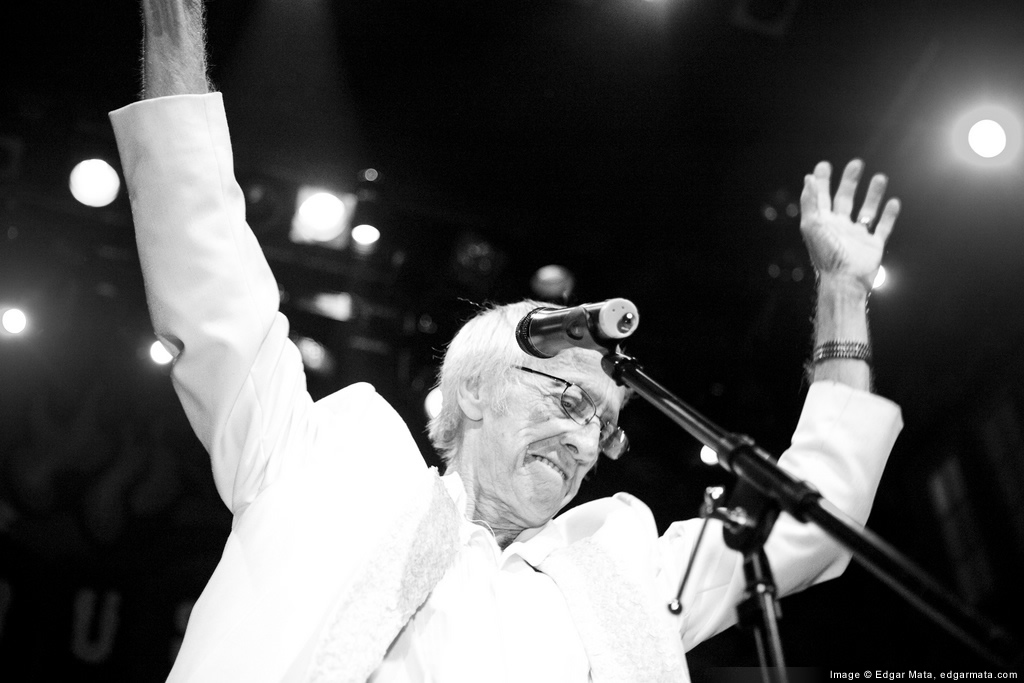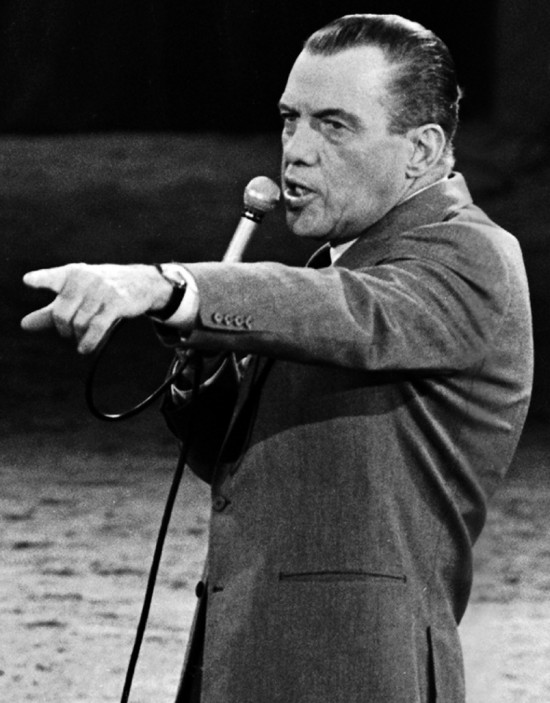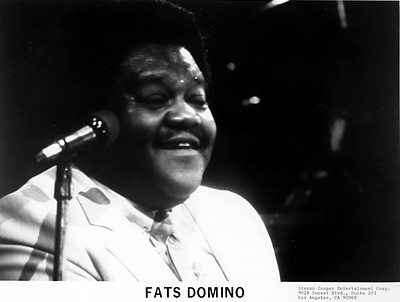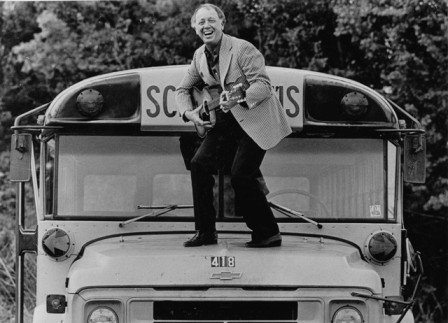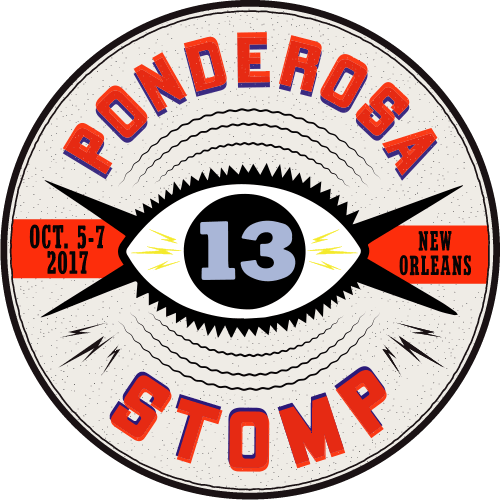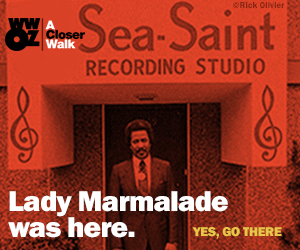WRITTEN BY BILL DAHL
When rock and roll was breaking out like wildfire six decades ago, causing the older generation conniption fits as it enticed youthful gyrations all around the world, Joe Clay was a dedicated and highly enthusiastic disciple, a teenage rockabilly wildman whose stage act achieved unbounded energy levels.
Happily, Joe brings that volcanic intensity to his blistering sets to this day. He ignited several previous Ponderosa Stomps with his athletic showmanship, and he’s ready to set the Rock ‘N’ Bowl ablaze this time around too.
“I’ll fire ‘em up!” promises Clay. “I just love what I’m doing.”
“I CAN PLAY THEM DRUMS”
Born with the mellifluous handle of Claiborne Joseph Cheramie on Sept. 9, 1938, in Harvey, La. (10 minutes outside of New Orleans, just across the river), Clay started young on his musical odyssey.
“When I was 12 years old, my mom and dad on Sundays would go to this country and western place, and they took me,” says Clay. “I’d watch that band all the time, but I’d watch the drummer. I kind of liked that drummer. There was something about drumming. So I told my dad one Sunday, I said, ‘I can play them drums!’ He said, ‘What?’ I said, ‘Gee, I think I can.’ So he went and asked the guy, could I sit in? And the dude says, ‘Yeah, come on!’ And I played, and I freaked ‘em all out ‘cause I played drums! And that’s how it started.
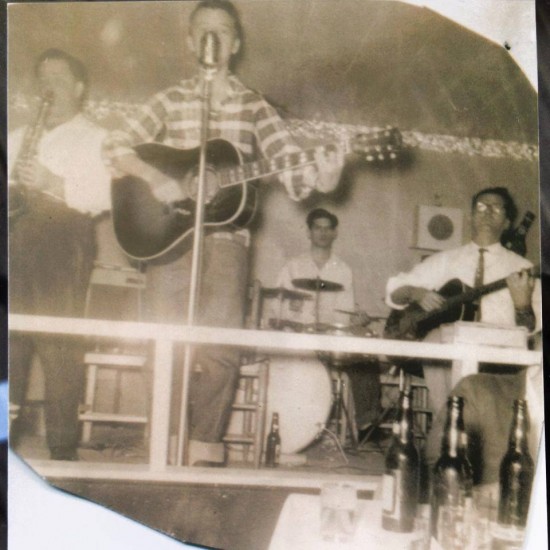
“Then a couple of years later, the same band, the drummer got sick and I took his place a few times. And they had a radio show every Saturday. And I went on the radio show every Saturday.” Broadcasting over WWEZ-AM with studios located in the Hotel New Orleans, Joe and the band he played with, Sonny Burns and the Trailsmen, specialized in “strictly country.”
FATS DOMINO “MADE ME FEEL GOOD”
But as time went on, that music couldn’t hold Joe’s interest. “It was kind of boring because it was kind of slow music,” he says. “One day I was listening to the radio and I heard Fats Domino, with that shuffle. And it made me feel good. I said, ‘I think that’s my niche right there. I like that!’ And then that’s when I started. We had two singers in the band. One guy would do the ballads, and I done the shuffles, the jitterbug stuff.”
The lad’s rising reputation was sufficient to get him on the fabled “Louisiana Hayride” up in Shreveport on Aug. 27, 1955. C.J. Cheramie shared the all-star bill, broadcast over WBOK-AM, with Jim Reeves, Lawton Williams, Jimmy Swan, Ernie Chaffin, Luke McDaniel, and a fast up-and-coming Sun Records star, Elvis Presley. “Oh, that was cool, man!” exclaims Joe. Four days later, Elvis found himself without drummer D.J. Fontana for a gig at Pontchartrain Beach Amusement Park.
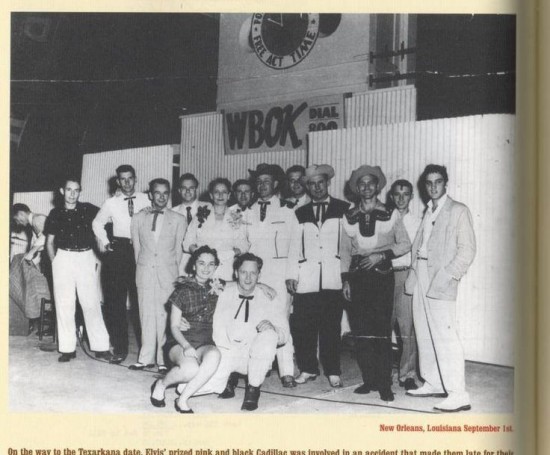
“His drummer was sick, couldn’t make it,” he says. “So I had just performed, and I was getting ready to leave, and he says, ‘Hey, Joe, can you play my set for me? Because the drummer couldn’t come.’ I said, ‘Sure, I can play it!’ ‘You know my stuff?’ ‘Yeah, I know it all! It ain’t no problem.’ Even if I didn’t know it, I could feel it. So that was it. That’s the first time in my life that I got paid twice. I got paid for me, and then he paid me.
“He was a regular dude,” adds Clay of Presley. “A beautiful guy. It was amazing. A few years later, I saw him at the Municipal Auditorium. He’d done a concert. And he was completely different. There was something about him that wasn’t right. I said, ‘My God, what happened?’” Joe also shared a bill with Carl Perkins at Pontchartrain Beach.
“THEY COME AND GOT ME”
Although RCA Victor had recently signed Presley as its flagship rocker, the mammoth label was on the lookout for more young artists of a similar bent in early 1956. WWEZ deejay Charlie “Jolly Cholly” Stokely, who booked talent at several nightclubs in the New Orleans area in addition to his daily on-air duties, fielded an inquiry from the company. “He was the disc jockey at the station that got me to make that tape,” says Joe. “That’s how that started.
“RCA was having a subsidiary called Vik, and they were looking for talent,” says Clay. “They sent a letter of some kind to that radio station, wanting to know if they knew anybody that’s got a little talent they’re looking for. And some of the band said, ‘Ahh, I’m not interested in that.’ I said, ‘I’ll do it!’ And then I sang, I played my guitar, and I done a tape right there, like ‘Flip Flop And Fly,’ something with a shuffle. And I sent it to ‘em, and like a couple of months later, they come and got me.”
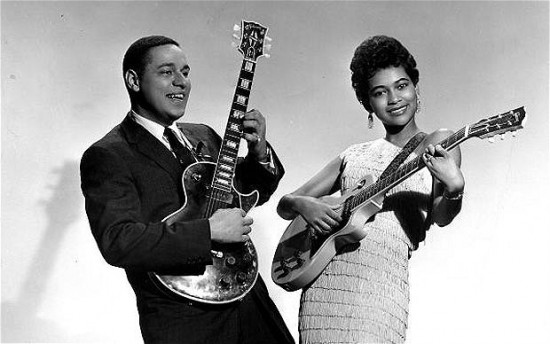
Fledgling Vik focused on straight pop music as much as R&B or rock and roll, though its talent roster would eventually encompass Mickey & Sylvia, Louis Jordan, Brook Benton, and New Orleans piano pounder Champion Jack Dupree (the logo folded in 1958). Herman Diaz Jr., whose A&R assignments at Vik ranged from perky pop chanteuse Gisele MacKenzie to the eternally swinging Treniers, produced Joe’s debut single. “He was great, man,” says Joe. “He was a beautiful guy.”
“MY NAME IS CLAIBORNE JOSEPH CHERAMIE”
Diaz accompanied his new recruit to Bill Quinn’s Gold Star Studios in Houston on April 25, 1956. One of Herman’s first brainstorms was to invent a new stage name for his discovery, apparently deeming C.J. Cheramie too difficult for non-Louisiana natives to wrap their tongues around.
“He done that on the plane, going to Houston,” remembers Clay. “My name is Claiborne Joseph Cheramie. That’s how he got Joe Clay.”
Armed with his new handle, Joe got thoroughly wild at Gold Star, backed by lead guitarist Hal Harris. “He was good,” says Clay, who tore into a pair of blazing covers to kick off the session. Diaz was in charge of choosing the material, and he didn’t have to look any further than the recent release schedule of Pappy Daily and Don Pierce’s Beaumont, Texas-based Starday label, which utilized Gold Star’s facilities often. “He picked ‘em all out,” says Clay. “I liked ‘em very much.”
“Duck Tail” had just been written and waxed on Starday by Texas rockabilly Rudy “Tutti” Grayzell, while “Sixteen Chicks” was the work of veteran Lone Star performer Link Davis, who happened to be on rhythm guitar for Joe’s version. Davis was past 40 by then; his Starday version of “Sixteen Chicks” swung handily, but it didn’t spew the molten fire of Clay’s cover. While Harris unleashed some savage guitar solos (he appeared on plenty of Starday rockabilly sessions and cut a handful of gems as a leader for the label, notably “Jitterbug Baby” and “I Don’t Know When”), Clay was less than knocked out by the trapsman he inherited that day.
https://www.youtube.com/watch?v=EN_jEPwGSOI
“Being a drummer, well, the drummer on this session, he was kind of slowing down on it,” says Joe. “What I can remember, we played like over and over. You know, like they said, ‘Take one. Take two. Take three.’ I mean, we had to do all kind of takes for him to really get solid in, you know? And I helped him the best I could. But he was a guy that looked at me like, ‘Who are you to tell me how to play?’ But I was trying to explain to him what we wanted, you know? And he just couldn’t get it. It wasn’t quite there. It was good, once we’d done it quite a few times.”
Three more rocking gems were waxed that day, but the echo-laden “Doggone It,” “Goodbye Goodbye,” and “Slipping Out And Sneaking In” were all relegated to RCA’s vaults at the time, finally surfacing almost three decades later when the German Bear Family label pressed up a full-length Clay album. All three listed one Wes Williams as writer (Jolly Cholly was his co-author on “Doggone It”). “That was a musician here in New Orleans,” says Clay. “He also played like country someplace else. He was a musician that played every night.”
https://www.youtube.com/watch?v=vhsMq_A3hMw
RCA apparently had high hopes for its new acquisition, designing a trade paper ad plugging “Sixteen Chicks” with three compelling action photos showing Clay singing and strumming a guitar and the slogan “Tic-tac-toe let’s go with Joe for more plays.” The company brought Clay to Chicago for a jukebox convention, where he met Nat King Cole (“Oh man, he was a great guy!”) and Bobby Darin. “Backstage, he sat way in the back, all by himself,” says Joe of Darin. “He didn’t talk to nobody.”
“I DON’T WANT THAT ON MY SHOW”
Clay came to New York that May to appear on stone-faced Ed Sullivan’s top-rated variety program on CBS-TV, headlined that particular Sunday evening by Cole. Things didn’t quite go as planned for the newcomer.
“We practiced all week for the show, doing ‘Ducktail,’” says Clay. “On Sunday, we’ve got the dress rehearsal. So they said, ‘Ladies and gentlemen, here’s Joe Clay!’ But the only ones in the audience now are your producers and managers. That’s all. The people, they didn’t come in yet. But (Ed’s) sitting on a stool for the whole show, to look at it. And when the guitar player kicked off ‘Ducktail,’ I came in boppin’! And man, he got off his stool and said, ‘Hold it! No, no! I don’t want that on my show!’ I said, ‘What? This is my song!’ He says, ‘I’m sorry, babe. I don’t want that on my show. None of that. None of that stuff!’
“So I wasn’t gonna go on. So then the producer, Herman, he came up onstage right quick, and he talked to Ed Sullivan for a couple of minutes. Still didn’t budge him. He says, ‘The only way he can come on my show — do you sing any kind of ballad or something?’ And then I got cute with him. I said, ‘I can sing anything you want! What do you want?’ He says, ‘Let me hear a ballad.’ So I had my guitar on. So I don’t know why, but ‘Only You’ came to my mind, and I started strumming that number by the Platters. And he says, ‘That’s it. That’s it. Just do that one, and you can get on my show!’ So that was it. That’s what we done.”
“THE PEOPLE COME RUNNING!”
While Joe was in New York, Diaz brought him into RCA’s Studio 1 on May 24 to cut another session, a scant month after the one in Houston. When he arrived, Clay was astonished to see an all-black band assembled for the occasion. “That kind of freaked me out, ‘cause of being from where I’m at,” he says. “I said, ‘That’s kind of crazy, man!’ But boy, was it good! It was so strong when we were recording. RCA’s got like seven studios right next to one another. And once we started playing, everybody came to see what all this excitement’s about.
“I’m telling you, the people come running! They were standing outside the glass, and they were all jumping around in the hall, man! It was crazy!”
On lead guitar was Mickey Baker, busiest axeman on the New York R&B studio scene (“Love Is Strange,” the lovey-dovey duet he waxed with singing partner Sylvia Vanderpool, would top the R&B charts in early 1957 on RCA’s Groove subsidiary). “He just sat down on his amp and just played, man,” says Clay. “Wow!” Skeeter Best held down the other guitar chair. Leonard Gaskin was on bass. Diaz really beefed up the backbeat by hiring two ace drummers, Bobby Donaldson and Joe Marshall, and having them play in tandem — a virtually unheard of strategy.
“That’s what made it so crazy, man!” says Joe. “I mean, the energy was totally unbelievable.” Despite the band’s shared R&B heritage, the results were pure rock and roll.
Herman handed Clay two numbers of the R&B persuasion that were twinned as his Vik encore, though you’d never know their origins from the rockabilly racket the studio combo cooked up. Atlanta-born blues shouter Titus Turner had cut his jumping composition “Get On The Right Track” four months earlier for Mercury’s Wing subsidiary, though it’s probably best known through Ray Charles’ late ‘56 rendition for Atlantic. Joe tore into it with a vengeance, Baker’s slashing riffs shadowing him every step of the way.
Penned by future Mercury A&R boss Clyde Otis and eventual Musicor Records founder Aaron Schroeder (under the alias of Doc Rockingham), the vicious grinder “Cracker Jack” was technically Joe’s property first; the Cues, New York’s top R&B backing vocal group, waxed a faster version for Capitol five days later. Baker’s mind-boggling 12-bar solo struck like a laser beam aimed right between the eyes, and Clay was every bit as fiery vocally.
“That was so incredible about the session. Take one, bam!” says Clay. “We just kept rollin’ on. It was unbelievable, man. Every time I think about that, I get all excited, man, because I remember all the energy that we had that night!”
“THEY GO NUTS, MAN!”
Once again, Vik never bothered to release a pair of stormers that were just as stunning as the two it did issue. “Did You Mean Jelly Bean (What You Said Cabbage Head)” was a catchy rocker with a nonsensical Bill Haley-style chorus that could have pulled some coin, but it was the fire-breathing “You Look That Good To Me,” another Otis copyright (this time in cahoots with bespectacled piano-tinkling R&B hitmaker Ivory Joe Hunter), that really shook the studio walls. Baker was never more crazed, and Joe sounded like he was losing his mind on the mic. Clay screamed, “Get hot or go home now!” midway through Mickey’s solo on take four; the whole chaotic thing barely broke the minute-and-a-half mark in length.
“That’s a good one,” says Joe. “Everywhere I go, I do that my last song and drive ‘em crazy. They go nuts, man!”
https://www.youtube.com/watch?v=86nENzJfy6Y
Unfortunately, two sessions held a month apart would be the sum total of Joe Clay’s RCA Victor legacy. A lack of gigs outside his homebase certainly didn’t help sell his two Vik singles. “Well, this was the reason: I had a manager, Jolly Cholly,” explains Clay. “Herman said, ‘Joe, you’ve got to get out on the road and promote.’ And my manager said, ‘You don’t need to do that. You just stay in New Orleans.’
“I DONE BOURBON STREET”
“Then a few months passed, and that’s when they said, ‘Sorry, we’re not gonna sign you again. You’re staying where you’re at.’ And that’s when I just about gave up Joe Clay, because I said, ‘Well, that’s it. I had a shot, and the opportunity’s gone.’ So that’s when I just stopped doing Joe Clay, and I got me a little trio and done the C.J. Cheramie Trio. And I done Bourbon Street, and I done conventions, and I done nightclubs.”
Along the way, Joe got to play with one of his idols. “This guy gave his wife a birthday party, and her favorite singer was Fats Domino,” he says. “So I played with a little trio. We played the birthday party. It was in the basement of the home. And he told us to take a break. He said, ‘I’ve got Fats Domino coming for my wife, and she knows nothing about it.’ ‘What?’ And sure enough he came, and he asked us, ‘Can y’all do my stuff?’ And naturally, we were all into Fats. And we played like a couple of hours with him that night. That was pretty cool.”
WAXING SWAMP POP AS “RUSS WAYNE”
Placing his Joe Clay identity in mothballs, C.J. Cheramie made his mark on Bourbon Street, his trio settling in at the 544 Club for five years. “I had a guitar player that lived in town, and I had an organ player, and he played the B-3,” says Clay. “He played the bass with his feet. So it was the three of us. And I done the drums and sang.” He crossed paths with Mac Rebennack, Frankie Ford, even Smiley Lewis during this period. “He was very quiet,” he says of Smiley, who was anything but that onstage.
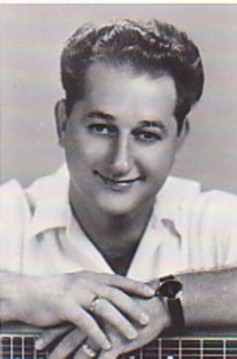
Joe wasn’t through recording, though he dreamed up another name to do it under. As Russ Wayne, he waxed three swamp-pop singles for Sammy Territo’s Gretna, La.-based Samter label. “I was in his record store one day, and he asked me if I was recording anymore,” says Clay. “I said no. And he said, ‘How would you like to try some of that?’ I said, ‘Yeah, I’ll try it, sure. ‘Cause I love it!’ You know, that’s my roots too. I come from here. I can do all of that. So we got Johnny Bonvillain. He’s a steel guitar player, one of the finest there is. And he wrote most of the songs.” As for his new moniker, “I don’t know how I got that name. I think I saw it somewhere. I said, ‘I like that!’”
“IT WAS THAT PAYOLA STUFF”
Bonvillain co-wrote both sides of the first Russ Wayne 45 on Samter, pairing “Can’t Get You Out Of My Mind” and “Don’t Know What To Do,” which hit local shelves in the summer of 1962. Recording for Samter at Cosimo Matassa’s fabled studio in the French Quarter, Clay didn’t allow the idiomatic shift to swamp pop to faze him in the slightest (having Rebennack on piano didn’t hurt its pungent bayou atmosphere one bit).
Two more Wayne singles emerged on Samter in 1963, the first coupling “Love You” and “My Heart Loves Only You” and the second featuring “I Get So Blue” and “My Little Darlin’.” Bonvillain was primarily responsible for writing all of them. “It really didn’t go no place but New Orleans, and I barely got airplay,” Clay says. “Because in them days, it was that payola stuff, and I didn’t have money. And he didn’t have the money to have to pay these guys.”
With no deejay support, the C.J. Cheramie Trio would be limited to personal appearances only after that. In 1971, Joe began driving a school bus in Gretna, a gig he held onto for the next three decades. But he’s quick to point out he was “still playing every night. I never quit music.
https://www.youtube.com/watch?v=4g_IiCYpKFw
“I was playing at the Last Roundup. That’s in Harvey,” he says. “Then I did a lot of hotel work for conventions. I still played every night, because the school bus was easy. It was like two hours in the morning, and two hours in the evening. Nothing to that.”
“THEY’RE LOOKING FOR HIM OVERSEAS!”
Even if his musical exploits had been all but forgotten at home, the name of Joe Clay was golden overseas, no doubt fueled by the 1983 release of his Bear Family LP “Ducktail.” That happy reality presented itself out of the blue in 1986. “That’s when I got rediscovered. That was really crazy,” says Joe. “This guy called me, Rene Coman Jr. He just came back from England with a band. And he asked his dad, because I played with his dad a lot, he said, ‘Didn’t Mr. C.J. go by the name of Joe Clay?’ And his dad said, ‘Yeah, years ago.’ And he said, ‘Man, they’re looking for him overseas!’ And he called me and told me that. And I said, ‘No, that’s 30 years ago! So I’m gonna tell you what’s happening: it’s somebody that’s using my name. That’s not me!’ And some of the songs that he said, I forgot about ‘em. I said, ‘Man, I don’t remember recording that!’
“About a month passed, and another dude called me. He said the same thing. He said, ‘Man, there’s guys looking for you!’ I said, ‘Who? Who is it?’ He said, ‘I just got back from England.’ Because he knew me. He knew who I was. So he got the guy’s phone number. So what I done, he gave it to me and I called the guy. I said, ‘Willie Jeffery, this is Joe Clay.’ He said, ‘Oh, my God! I finally found you!’
“He said, ‘How would you like to do a tour over here?’ I said, ‘What, in England?’ He says, ‘Yeah, I could get you about five jobs here. Man, they would go crazy for you over here! You’ve been a hit over here for a couple of years!’ I said, ‘What?’ I mean, it was just blowing my mind. So I said, ‘OK, let’s do it!’”
“IT IS HIM! HE’S ALIVE!”
The resurrection of Joe Clay was under way. Before long he found himself in England, ready to embark on a new and entirely unexpected chapter of his musical career. “When he was getting ready to bring me onstage, they turned all the lights out,” says Joe. “And when he introduced me and I jumped onstage, they had a big light that hit me. And when it did, all the fans in the front were just falling over, passing out like! I said, ‘Oh, my God! What’s going on?’ And what had happened, they thought I was dead! And when they seen me, it was just I guess too much to bear. They went, ‘Wow, it is him! He’s alive!’ I’ll never forget that, man.
“That was insanity. It never stopped,” he says. “In fact, it keeps getting bigger and bigger.”
Joe has been a regular overseas visitor ever since, tearing up stages wherever he roams. In 2004, he cut a fresh album, “The Legend Is Now,” for the Spanish El Toro label. He’s got a Japanese tour lined up for later this year. Naturally, Clay looks forward to scorching the Stomp stage on Oct. 2. “Even today, I sit down, and when I’m by myself I start thinking and saying, ‘Man, what is happening here?’” he exclaims. “I just got back from Italy. That was unbelievable. It was insane.
“Next year is going to be the biggest year I ever had for Joe Clay. Usually I’ve got at the most two or three jobs overseas a year. That’s the most. Next year I’m going to have about ten. I’m going to Australia. I’m going to Holland. I’m going to Germany. I’m going to England. I’m going to France.
“It’s just crazy!”
See the inimitable Joe Clay at the 2015 Ponderosa Stomp late Friday night, Oct. 2.



